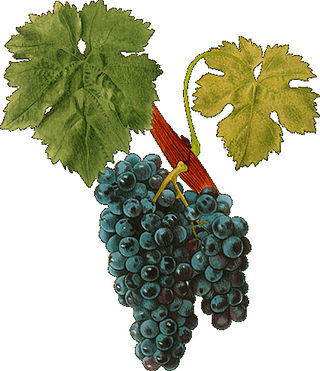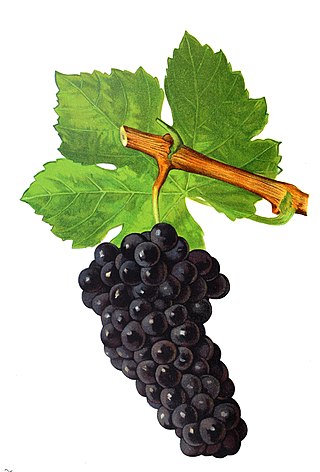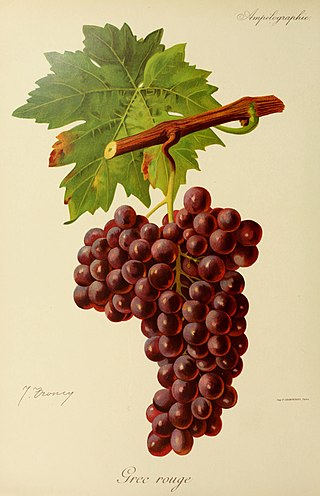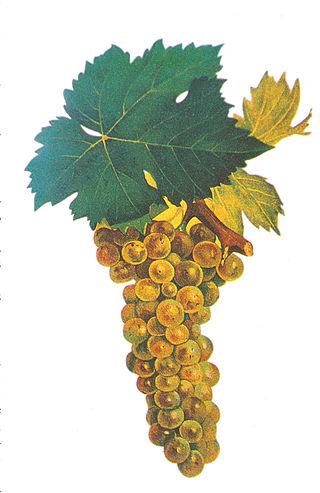Related Research Articles

Syrah, also known as Shiraz, is a dark-skinned grape variety grown throughout the world and used primarily to produce red wine. In 1999, Syrah was found to be the offspring of two obscure grapes from southeastern France, Dureza and Mondeuse Blanche. Syrah should not be confused with Petite Sirah, a cross of Syrah with Peloursin dating from 1880.

Malbec is a purple grape variety used in making red wine. The grapes tend to have an inky dark color and robust tannins, and are known as one of the six grapes allowed in the blend of red Bordeaux wine. In France, plantations of Malbec are now found primarily in Cahors in South West France, though the grape is grown worldwide. It is increasingly celebrated as an Argentine varietal.

Carignan is a red grape variety of Spanish origin that is more commonly found in French wine but is widely planted throughout the western Mediterranean and around the globe. Along with Aramon, it was considered one of the main grapes responsible for France's wine lake and was a substantial producer in jug wine production in California's Central Valley but in recent years, it has been reborn as a flagship wine for many cellars in the south of France as well as in Catalonia.

Durif is a variety of red wine grape primarily grown in Australia, California, France, and Israel. Since the end of the 20th century, wineries located in Washington's Yakima River Valley, Maryland, Arizona, Texas, West Virginia, Chile, Mexico's Baja California Peninsula, and Ontario's Niagara Peninsula have also produced wines from Durif grapes. It is the main grape known in the U.S. and Israel as Petite Sirah, with over 90% of the California plantings labeled "Petite Sirah" being Durif grapes; the U.S. Bureau of Alcohol, Tobacco, Firearms and Explosives (ATF) recognizes "Durif" and "Petite Sirah" as synonyms for the same grape. It produces tannic wines with a spicy, plummy flavour. The grape originated as a cross of Syrah pollen germinating a Peloursin plant. On some occasions, Peloursin and Syrah vines may be called Petite Sirah, usually because the varieties are extremely difficult to distinguish in old age.

Furmint is a white Hungarian wine grape variety that is most noted widely grown in the Tokaj-Hegyalja wine region where it is used to produce single-varietal dry wines as well as being the principal grape in the better known Tokaji dessert wines. It is also grown in the tiny Hungarian wine region of Somló. Furmint plays a similar role in the Slovakian wine region of Tokaj. It is also grown in Austria where it is known as Mosler. Smaller plantings are found in Slovenia where it is known as Šipon. The grape is also planted in Croatia, where it is known as Moslavac. It is also found in Romania and in former republics of the Soviet Union. Furmint is a late ripening variety. For dry wines the harvest starts usually in September, however sweet wine specific harvest can start in the second half of October or even later, and is often affected by Botrytis.

Grenache or Garnacha is one of the most widely planted red wine grape varieties in the world. It ripens late, so it needs hot, dry conditions such as those found in Spain, where the grape most likely originated. It is also grown in the Italian island of Sardinia, the south of France, Australia, and California's Monterey AVA and San Joaquin Valley.

The Muscat family of grapes includes over 200 grape varieties belonging to the Vitis vinifera species that have been used in wine production and as raisin and table grapes around the globe for many centuries. Their colors range from white, to yellow, to pink to near black. Muscat grapes and wines almost always have a pronounced floral aroma. The breadth and number of varieties of Muscat suggest that it is perhaps the oldest domesticated grape variety, and there are theories that most families within the Vitis vinifera grape variety are descended from the Muscat variety.

Trollinger, Schiava, or Vernatsch, is a red German/Italian wine grape variety that was likely first originally cultivated in the wine regions of South Tyrol and Trentino, but today is almost exclusively cultivated on steep, sunny locations in the Württemberg wine region of Baden-Württemberg. It is primarily known under the synonyms Trollinger in Germany, Vernatsch in South Tyrol and Schiava in other Italian regions. As a table grape the variety is sometimes known as Black Hamburg, which is commonly confused with the similar synonym for Black Muscat—a variety that is actually a cross of Trollinger and Muscat of Alexandria.

Barbaroux is a pink-skinned French wine grape variety grown in southeastern France. It is a permitted variety in the appellation d'origine contrôlée wine of Cassis in Provence as well as in the Ajaccio region of Corsica. While it is sometimes known under the synonym "Barbarossa", DNA profiling has shown the Barbaroux grown in Provence is distinct from the Barbarossa vines grown in Liguria and Piedmont and is likely unrelated to all Italian Barbaross vines. There is also debate among ampelographers about whether the Barbaroux vines in Provence and Corsica are the same grape or separate Vitis vinifera varieties.

Muscat Blanc à Petits Grains is a white wine grape of Greek origin that is a member of the Muscat family of Vitis vinifera. Its name comes from its characteristic small berry size and tight clusters. It is known under a variety of local names such as Moscato bianco, Muscat blanc, Muscat Canelli, Muscat de Frontignan, Muscat de Lunel, Muscat d'Alsace, Muskateller, Moscatel de Grano Menudo, Moscatel rosé and Sárgamuskotály.
Plantet is a red wine grape variety that was one of the hybrid grape created by French physician and grape breeder Albert Seibel. While the exact parentage of the grape is unknown, the most popular theories has it as a cross of two Seibel grapes, Seibel 867 x Seibel 2524 with another theory speculating that Plantet's parentage was Seibel 4461 crossed with Berlandieri-Jacquez.

Bobal is a variety of Vitis vinifera, a red grape used in winemaking. It is native to the Utiel-Requena region in Valencia, Spain. The presence of Bobal in Utiel-Requena was documented in the 15th century in "Espill o llibre de les dones” by Jaume Roig. The name derives from the Latin bovale, in reference to the shape of a bull’s head.

Moscato Giallo or Yellow Muscat is a white Italian wine grape variety that is a member of the Muscat family of grapes. Known for its large deep cluster of loose, deep-yellow berries and golden colored wine, Moscato Giallo is grown mostly in northern Italy where it is most often used to produce passito style dessert wines. The grape is also planted in Croatia where it is known as Muškat žuti.
Cereza is a white Argentine wine grape variety. Like Gewürztraminer and Pinot gris, Cereza is a pink skinned variety. It is a crossing of Muscat of Alexandria and Listan negro.

Calitor or Calitor noir is a red French wine grape variety. It was previously widely cultivated in southern France, in particular in Provence, but is now very rare, almost extinct. Historically used as mainly a blending variety, Calitor gives high yields and produces a light-bodied and lightly colored wine. When grown on hillside sites, it can give a wine of character.
Girò is a red Italian wine grape variety that is grown on Sardinia and is used mostly in the production of fortified wines in the Giro di Cagliari Denominazione di origine controllata (DOC). The grape was once widely planted throughout Sardinia but its plantings were decimated when the phylloxera epidemic hit the island at the end of the nineteenth century. At the turn of the 21st century there were 552 hectares of the grape planted throughout Italy, mostly in the Sardinian provinces of Cagliari and Oristano.
Pascale di Cagliari is a red Italian wine grape variety that is grown in Sardinia.

Nosiola is a white Italian wine grape variety that is grown in the Trentino region north of Lake Garda in the Valle dei Laghi. Here it is used in varietal Denominazione di origine controllata (DOC) wines and as a blending component in wines such as Sorni Bianco from Trento. It is also used to produce a dessert wine in the Vin Santo style from grapes that have been allowed to dry out prior to fermentation.
Donzelinho branco is a white Portuguese wine grape variety that is classified as one of the "Very Good" varieties authorized to be used in Port wine production. While rarely seen as a varietal wine, Donzelinho branco is a permitted variety in the white blends of several northern Portuguese wine regions including the Denominação de Origem Controlada (DOC) of Douro and Trás-os-Montes and the Vinho Regional (VR) wines of Duriense and Transmontano.
Bianchetta Trevigiana is a white Italian wine grape variety that is grown in the Trentino-Alto Adige/Südtirol and Veneto wine regions of northeast Italy. Here the grape is rarely used a varietal but, instead, is a permitted blending grape adding acidity to the wines of several Denominazione di Origine Controllata (DOC) zones including the sparkling wine Prosecco and has also been used for vermouth production. The name Trevigiana is derived from the province of Treviso where the grape is believed to have originated from.
References
- ↑ J. Robinson Jancis Robinson's Guide to Wine Grapes pg 34 Oxford University Press 1996 ISBN 0-19-860098-4